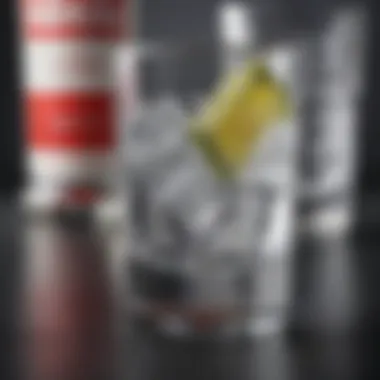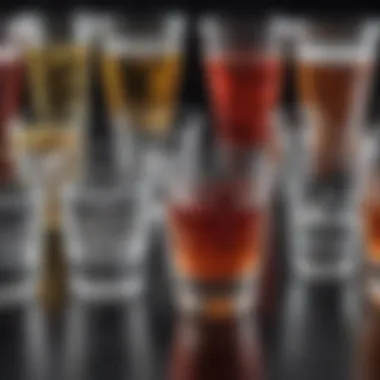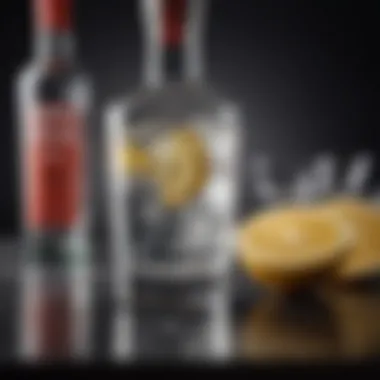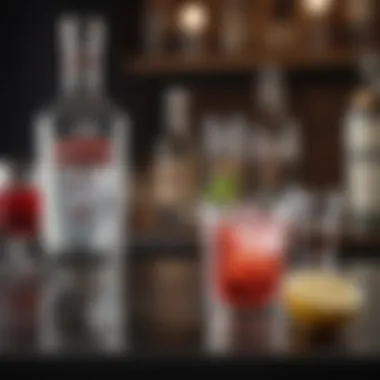Understanding Vodka Shot Volumes and Measurements


Intro
When it comes to enjoying vodka, understanding what makes up a shot is crucial. This goes beyond just a matter of measurements; it dives into cultural practices, the roles of bartenders, and even health factors. The world of vodka is vast and complex, with varying norms from one place to another, and this article will act as a lodestar. Whether you're ordering your drink at a bustling bar or pouring at a house party, knowing the specifics can enhance your experience in ways you might not have considered before.
How did these quantities come to be so precise yet so diverse? The intricacies of a vodka shot often reveal more than just how much liquid is in the glass; they hint at deeper traditions and the social nature of sharing drinks with friends or loved ones.
"A shot of vodka is not just a measurement; it's a cultural bond, a gateway to experiences shared over laughter and stories."
Understanding this volume provides insights into responsible drinking too. As we delve deeper into this topic, we will highlight the standard practices, the regional differences, and the implications on both consumers and bartenders. So, let's raise our glasses, not just in toast, but in quest for knowledge.
Prelude to Vodka Measurements
Understanding vodka measurements is more than just pulling out a measuring cup; it sets the stage for how we enjoy this popular spirit across the globe. When it comes to vodka, measuring a shot becomes a blend of art and science. Why does it matter? Well, when you recognize how different cultures perceive a shot, or how a bartender’s precision can change the drinking experience, you start to appreciate vodka on a whole new level. This segment highlights the nuances involved in defining a shot, along with the global perspectives on vodka serving sizes.
Defining a Shot
A shot is typically seen as a standard measure for spirits, yet its definition can be slippery like ice in a cocktail shaker. In many contexts, a shot is considered to be approximately 1.5 ounces or about 44 milliliters. However, this isn't a one-size-fits-all situation. Some bars might serve a hefty 2-ounce pour, while others might stick to a modest 1-ounce serving. The variance often leads to confusion, particularly for the uninitiated. It’s important to note that what one region deems a standard shot can vastly differ from another. For instance, in the United States, most people expect a shot to be 1.5 ounces, whereas, in some parts of Europe, shots can be smaller or larger depending on local customs.
"One inch of a ruler can mean different lengths around the world. Likewise, a shot can quench your thirst to different degrees!"
Global Perspectives on Vodka Serving Sizes
Vodka isn't just a drink; it’s rooted in cultural traditions that shift how it’s served and consumed. You'll notice that in places like Russia or Poland, vodka is often served in smaller glasses, around 50 milliliters, and is accompanied by food to enhance the experience. In comparison, an American-style vodka martini might see its measurements inflated with a splash of vermouth, often presenting something akin to 3 or 4 ounces in total.
This cultural inclination towards larger or smaller servings reflects not just preference but also tradition and social context. For instance:
- In Russia, there's a customary way to raise a shot with a toast, emphasizing camaraderie.
- In Sweden, vodka is often enjoyed during celebratory meals, where the serving size becomes symbolic.
- Meanwhile, in trendy cocktail bars around the world, unique vodka shots can be presented with creative flair, leading to their own distinctive measures.
With all this in mind, it's apparent that the definition of a shot isn't merely about volume; it’s a window into social practices and an appreciation for the drink itself.
Standard Measurement of a Shot
Understanding the standard measurement of a shot is crucial for both consumers and bartenders alike. Measuring vodka correctly not only affects the taste and experience of the drink but also has implications for health and responsible consumption. Precision in measurements contributes to maintaining consistency in cocktails and ensures a satisfying drinking experience, enabling drinkers to better appreciate the nuanced flavors of the vodka.
When vodka enthusiasts wander into a bar, knowing what counts as a shot helps them gauge what they are ordering. This knowledge can enhance their appreciation for the drink, making it more than just a quick down-the-hatch experience, but rather a deliberate selection enjoyed in moderation. Just as important, bartenders who understand shot measurements can create cocktails that meet customer expectations while delivering on flavor and presentation.
Typical Volume in Milliliters
In most countries, a standard shot of vodka typically contains about 44 milliliters, though many folks commonly see this as 30 milliliters or even an ounce. This measurement is crucial because it sets a baseline for understanding both strength and volume in beverage servings. Indeed, pouring beyond this threshold could alter the drinker's experience, potentially leading to a quick buzz, or worse, overindulgence.
Here are a few key points about the typical volume:
- United States: A shot commonly measures 44 milliliters or 1.5 ounces.
- United Kingdom: A standard shot sits around 25 milliliters, which fits in line with their drinking culture.
- Japan: The traditional Japanese serving size for spirits often comes in at about 30 milliliters, closely mirroring global averages.
This range not only represents local customs but can also shift between bars or even between friends depending on the context. Whether pouring for a shot of celebration or measuring for a cocktail, understanding these typical volumes is fundamental.
Variations by Region
When it comes to vodka shot sizes, cultures across the globe often sport their own particular standards and traditions. Take the time to examine a few of these variations further:


- Eastern Europe: In countries like Russia and Poland, a shot can range from 50 to 100 milliliters. This reflects a more communal drinking style that fosters friendship and celebration.
- Scandinavian Countries: Countries like Sweden and Finland often pour similar sizes as their Eastern European counterparts, emphasizing the importance of vodka in social situations.
- South America: In countries like Brazil, vodka is commonly used in cocktails, and therefore the measurements might vary depending on whether it's served solo or mixed with juice or soda.
Understanding these variations helps break down cultural contexts, which play a significant role in how vodka is consumed worldwide. Learning about these distinctions makes for an excellent conversation starter as well, whether you’re at a bar with friends or at a dinner with new acquaintances.
"The way a drink is measured can tell you quite a bit about the culture from which it originates - it’s more than numbers, it’s a reflection of social practices."
As you can see, being mindful of these regional intricacies not only enriches one’s drinking experience but also fosters a respectful appreciation for the traditions that surround vodka consumption.
Comparative Analysis with Other Spirits
Analyzing the volume of vodka in conjunction with other spirits like whiskey and gin sheds light on not just the cultural contexts surrounding each drink, but also the expectations when it comes to serving sizes. This analysis is crucial, as it allows consumers and bartenders alike to understand the subtleties that differentiate these spirits. It highlights the notion of tradition, personal preference, and even health considerations that accompany the act of measuring out a shot. Without this comparative lens, one might overlook underlying factors that influence how these spirits are perceived and enjoyed.
Whiskey and Gin: Standard Shot Sizes
When it comes to whiskey, the standard shot size often mirrors that of vodka—typically resting between 1.5 ounces (approximately 44 milliliters) in the U.S. and 50 milliliters in several other countries. This consistency allows consumers to have a predictable experience, regardless if they choose bourbon or a smooth scotch. Yet, when whiskey is served neat, it’s common to encounter a slightly smaller pour, generally in the realm of 1 ounce (around 30 milliliters). This variation can be attributed to flavor intensity. Whiskey tends to carry a more robust profile, warranting a consideration for those who prefer to sip rather than down in a single gulp.
Similarly, gin often falls into that same standard of 1.5 ounces, especially when paved into cocktails like a gin and tonic or martini, where its fragrant botanicals can truly shine. However, gin's versatility also allows bartenders to alter the standard pour to create layered tastes without overwhelming the palate.
Cocktail Mixes and Their Measurements
Contrary to a simple shot of vodka, the measured volume in cocktails often fluctuates based on the recipe, ingredients, and intended flavor impact. For instance, a classic vodka martini generally calls for two parts vodka to one part dry vermouth, effectively allowing the spirit to be paired with complementary flavors while still holding its own.
In general, cocktails tend to use a variety of measurements, leading to rich and multifaceted experiences. Consider a cosmopolitan—a popular choice—consisting of 1.5 ounces of vodka, 1 ounce of cranberry juice, and a splash of lime. This layering of ingredients transforms the drink, showcasing how different spirits can work together.
For clarity, here are some examples of commonly-used measurements in cocktails:
- Margarita: 2 ounces tequila, 1 ounce lime juice, 1 ounce triple sec
- Mojito: 2 ounces rum, 1 ounce lime juice, 2 teaspoons sugar, plus mint and soda water
- Bloody Mary: 1.5 ounces vodka, 3 ounces tomato juice, with a medley of spices and seasonings
The measurement nuances blend into the broader conversation about spirits, where the concept of a shot takes on different meanings in various cultural and cocktail contexts.
By understanding these varied practices, fans of spirits can navigate their preferences and expectations when it comes to servings. This awareness plays a pivotal role in ensuring a richer experience—whether drinking vodka alone or as part of a carefully crafted cocktail.
Cultural Significance of Vodka Consumption
Vodka is more than just a drink; it is woven deeply into the fabric of many cultures, particularly in Eastern Europe. The way vodka is consumed often reflects social norms, historical legacies, and even spiritual beliefs. Understanding its cultural significance helps us grasp why vodka isn’t merely about intoxication but also about community, tradition, and identity.
The act of sharing vodka can symbolize hospitality and warmth. In Slavic cultures, offering a shot to a guest is considered a gesture of respect and friendship. When friends gather, the ritual of drinking vodka often accompanies their conversations, adding depth to social interaction.
Additionally, in various celebrations and milestones, vodka comes forward as a drink of choice. It's present in weddings, birthdays, and other significant events. Each occasion might carry its unique way of drinking vodka, either through toasts or in specific rituals, highlighting its importance to those moments. For learning about vodka, we should look at these rich traditions and what they signify, including:
- Connection: Vodka fosters bonds among people. When sharing a drink, stories flow and connections deepen.
- Tradition: Rituals surrounding vodka are passed down through generations, preserving historical significance.
- Symbolism: Vodka can represent birth, life, and death, playing roles in various ceremonies.
In sum, appreciating the cultural nuances behind vodka can offer insights into communities that cherish this spirit. These patterns of consumption embody collective memories and shared experiences that shape identities.
Vodka in Slavic Traditions
In the slavic lands, vodka is often termed the"water of life". Its consumption widely permeates both daily life and special occasions. Folklores popularize its origin as a beverage created for the revival of health and spirit. Each region may have its own variation, but the essence remains universal.
Traditionally, vodka drinkers abide by certain social protocols, particularly the ritual of "toasting". The one who raises the glass often says a few heartfelt words, followed by a communal shout of "Na zdorovie!". This moment reinforces camaraderie and respect among participants.


Moreover, vodka is intricately tied to rituals. For instance, in some regions, it is customary to take a shot before the commencement of a meal to honor the table and those seated.
Symbols and Rituals Associated with Vodka
Vodka represents a myriad of cultural nuances. For many Slavic people, it is not just a drink but a symbol of hospitality, friendship, and celebration. The act of drinking vodka transcends mere consumption; it transforms into a ceremonial practice. Here are some notable symbols and rituals:
- Toast and Thanks: Before taking a shot, it is customary to dedicate the drink to someone or something, be it health, happiness, or remembrance of the deceased. This act imbues the drinking experience with deeper meaning.
- Shot Glasses and Chasers: The choice of glassware can vary by culture, with specific designs reflecting regional artistry. Pairings, like pickles or bread, serve as chasers, showcasing traditional food that complements the drink.
"In vodka we trust," echoes in many households, emphasizing the drink's role in celebrating life's moments.
- Memorial Rituals: In some communities, vodka is imbibed in remembrance during funerals or memorials. The drink serves as a bridge between the living and the memories of those who have passed.
Overall, vodka carries rich cultural meaning that resonates through time and generations. Its consumption is steeped in social interactions which add layers to its significance beyond the glass.
Health Considerations
When we delve into the realm of vodka consumption, health considerations can't be overlooked. The dance between enjoyment and well-being is delicate. Vodka, like any other alcohol, carries with it both potential benefits and pitfalls. Understanding its impact on health can guide consumers toward making choices that favor their well-being while still enjoying social occasions.
Recommended Guidelines for Alcohol Consumption
A crucial part of the conversation surrounding vodka—and alcohol in general—is adherence to recommended guidelines. These guidelines can serve as a map for safe consumption, helping one navigate the choppy waters of indulgence. The Centers for Disease Control and Prevention (CDC) suggests that moderate drinking is generally defined as up to one drink per day for women and up to two drinks per day for men. It's key to note that these measures are not just arbitrary numbers; they stem from extensive research on alcohol’s interaction with various health parameters.
Using this guideline, a standard shot of vodka, which typically contains about 1.5 ounces (roughly 44 milliliters), factors into these recommendations. For instance, if a woman enjoys a shot of vodka at a celebration, she should consider her overall intake throughout the day, ensuring it doesn’t exceed the one-drink recommendation. Awareness of one’s limits is essential. It’s wise to be cautious if one’s health history includes issues like liver disease or any medications that interact negatively with alcohol.
"Understanding alcohol guidelines allows individuals to maintain their health while still participating in social activities."
Impact of Vodka Serving Sizes on Health
The size of a vodka shot can significantly influence its effects on health. Larger servings naturally lead to higher alcohol intake, which can ramp up the risks associated with drinking. For example, a typical shot might seem harmless, but when served in a heavier glass or poured more generously, the outcome can be quite different. This shift can tip someone from moderate drinking to heavier consumption, with potential repercussions for both short-term enjoyment and long-term health.
Research indicates that the rate of drinking also plays a role. If a person downs several shots quickly, it can lead to increased intoxication more rapidly than might be anticipated. The body processes alcohol over time, and when consumed in large quantities or reduced timeframes, it can lead to acute health risks such as alcohol poisoning, accidents, or even longer-term effects like liver damage.
- Considerations include:
- Serving size awareness: Larger shots = increased risk.
- Consumption pace: Slow sips vs. quick shots matters.
- Health history: Consider any pre-existing conditions.
Practical Applications for Bartenders
When it comes to serving vodka, the role of bartenders is crucial. They don't just mix drinks; they set the stage for the entire experience. Understanding the volume of a standard shot is not just about measurement; it’s about ensuring a consistent product that meets customer expectations. The practical applications of this knowledge are manifold, from ensuring customer satisfaction to managing costs effectively.
One critical aspect is accuracy in pouring. A bartender who consistently uses a defined shot size can maintain a stable cost of goods sold. This attention to detail can directly affect profit margins. When a bartender uses jiggers — tools designed to measure out specific quantities — they can ensure each drink is produced with the same standard measurements. Using jiggers becomes essential in maintaining both consistency and quality across all servings.
Using Jiggers for Accurate Measurement
Jiggers come in various sizes, usually ranging from 0.5 to 2 ounces, making it easier to serve cocktails with precision. Using jiggers reduces the variability that can often occur in free-pour methods, where a bartender's pour might differ significantly from one shot to the next.
- Benefits of using jiggers:
- Accuracy: Helps ensure the right mix of ingredients, maintaining the drink's intended flavor profile.
- Standardization: Ensures each cocktail is consistent regardless of who’s bartending that night.
- Waste Reduction: Less spillage or over-pouring means less wastage and reduced costs for the bar.


Furthermore, it’s important for bartenders to continuously familiarize themselves with jigger sizes and how they align with standard shot volumes. This not only ensures accuracy but also instills confidence in their serving practices.
Consistency in Serving Vodka
The phrase "consistency is key" rings especially true in the hospitality industry. Patrons expect a particular standard when ordering a shot, whether at a high-end cocktail bar or a casual pub. When a bartender serves a 1.5-ounce shot every time, customers come to trust that their vodka will always be just as they like it.
- Key points to maintain consistency include:
- Training Staff: Ensuring that all bartenders know how to measure accurately and understand the importance of shot sizes.
- Regular Equipment Maintenance: Keeping jiggers and other measuring tools clean and functional.
- Standard Recipes: Having well-defined recipes that specify shot sizes for cocktails helps achieve uniformity.
Establishing these practices helps in building a reliable reputation for the establishment. Moreover, it enhances the overall drinking experience for customers, making them likely to return. Just as importantly, well-measured shots can make or break a cocktail; this attention to detail reflects a bar's commitment to quality.
Tip: Regularly remind staff to always check their jigger measurements, as even small discrepancies can lead to larger inconsistencies over time.
Influence of Modern Trends
The landscape of vodka consumption is ever-evolving, with new trends reshaping how people perceive and enjoy this spirited drink. This influence underscores the broader cultural shifts regarding alcohol consumption, driving both consumers and bartenders to adapt their practices. Understanding these trends provides essential insights that go beyond mere preferences, touching on social dynamics, environmental awareness, and a move toward personalization in drinking experiences.
Craft Vodka Movement
One of the most noteworthy trends in recent years has been the emergence of the craft vodka movement. This surge reflects a growing appreciation for artisanal production methods. Unlike mass-produced spirits, craft vodka often emphasizes high-quality ingredients, innovative distillation techniques, and unique flavor profiles. It lends itself to a more sustainable approach, with many producers opting for organic grains and eco-friendly practices.
In many regions, consumers are increasingly drawn to locally-sourced vodkas that tell a story. This connection to place fosters a relationship between the consumer and the product, making drinking a more meaningful experience. For bartenders, incorporating craft vodka into cocktails allows for a creative edge, introducing new flavors that can elevate a simple vodka tonic to exciting new heights.
As an example, some craft vodkas experiment with flavors like peppercorn, cucumber, or even lavender, which speaks to the endless possibilities for customization. The notion of a "shot" is expanded to not only signify volume but also the experience it offers, catering to drinkers who desire something distinctively different.
Changing Attitudes Toward Alcohol Serving Sizes
A noticeable shift in societal attitudes towards alcohol consumption has emerged, particularly in relation to serving sizes. More people are becoming conscious of moderation, which is changing how drinks are ordered and consumed. The traditional shot glass filled to the brim may be giving way to a more measured approach, as patrons seek to savor flavors rather than simply consume for inebriation.
This change is particularly evident in environments that prioritize a responsible drinking culture. Bars are starting to offer smaller serving sizes and tasting flights, allowing customers to explore various vodkas without overindulgence. It aligns with the global trend toward health and wellness, where consumers choose quality over quantity.
As consumers become more educated about their choices, the demand for transparency regarding alcohol content and sourcing increases. This has led to industries reevaluating their marketing strategies, as they emphasize lower-calorie options and the craftsmanship behind the spirit.
"With the rise of mindful drinking, less is often more. People are opting for shots that are more than just about intoxication; they want an experience."
In summary, the modern trends in vodka consumption are not just about the spirit itself but also reflect an evolving culture that values quality, sustainability, and responsibility. Understanding these shifts can enhance one’s appreciation of vodka, transforming what constitutes a shot into a more nuanced experience.
Closure: The Essence of a Shot of Vodka
The exploration of vodka measurement and its cultural implications underscores the importance of understanding what constitutes a shot. Not only is it a matter of volume, but it also encompasses a variety of meanings, traditions, and health considerations. Recognizing the complexities involved in serving and consuming vodka can enhance one’s appreciation for this versatile spirit.
Recap of Key Points
- A standard shot typically measures around 1.5 ounces or 44 milliliters, but this can vary by region and context.
- Cultural practices surrounding vodka, especially in Slavic regions, emphasize its role in social rituals and gatherings where sharing is paramount.
- The rising craft vodka movement has introduced a variety of flavors and artisanal approaches, making vodka consumption more diverse and personalized.
- Health guidelines suggest moderate consumption to enjoy vodka responsibly, considering its impact on the body over time.
Ultimately, understanding vodka shots is not only about the quantity poured into a glass, but also about the significance it holds in various settings. Acknowledging both traditional and modern approaches can inform better choices for enthusiasts and drinkers alike.
Future Perspectives on Vodka Consumption
Looking ahead, the landscape of vodka consumption is bound to evolve. There’s an increasing trend towards craft spirits, including locally produced vodkas that focus on unique ingredients and flavors. The appreciation for quality over quantity is gaining traction, leading many to favor fewer, better-crafted drinks. Moreover, shifts in health awareness and responsible drinking practices will likely influence serving sizes and consumption patterns.
The conversation surrounding vodka will continue to expand. As consumers seek experiences beyond traditional norms, we may witness new serving rituals emerge that blend cultures and practices. The dialogue regarding vodka remains vibrant and ever-changing, mirroring the drink’s adaptability in modern society.
"A shot of vodka is more than just a drink; it's a shared experience, a nod to tradition, and a celebration of craft."
Through understanding these dimensions, vodka lovers and bartenders can navigate this spirit's world with greater insight and respect.



